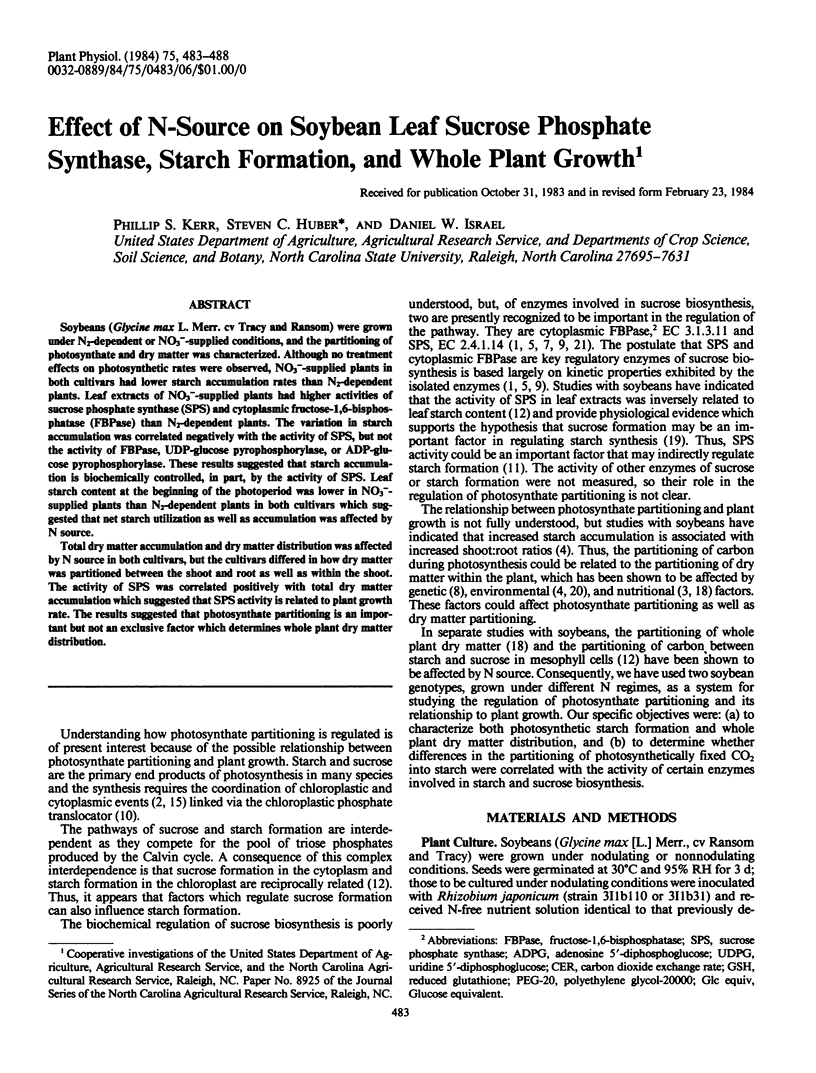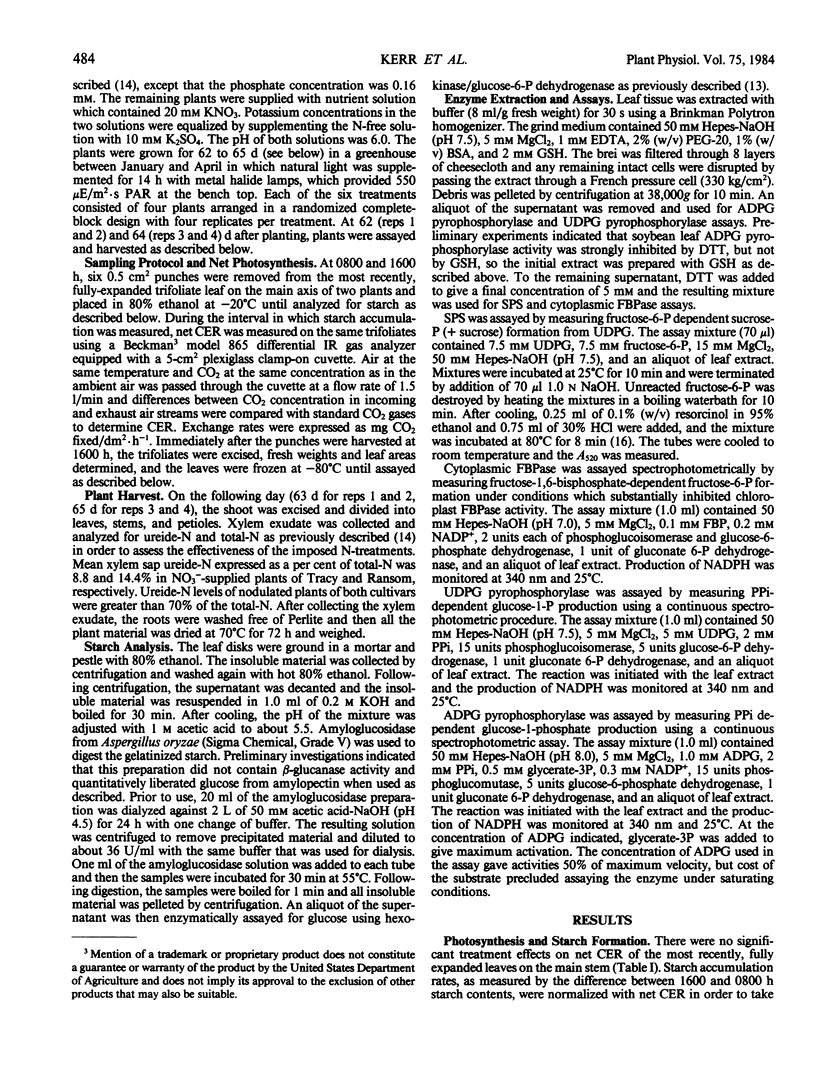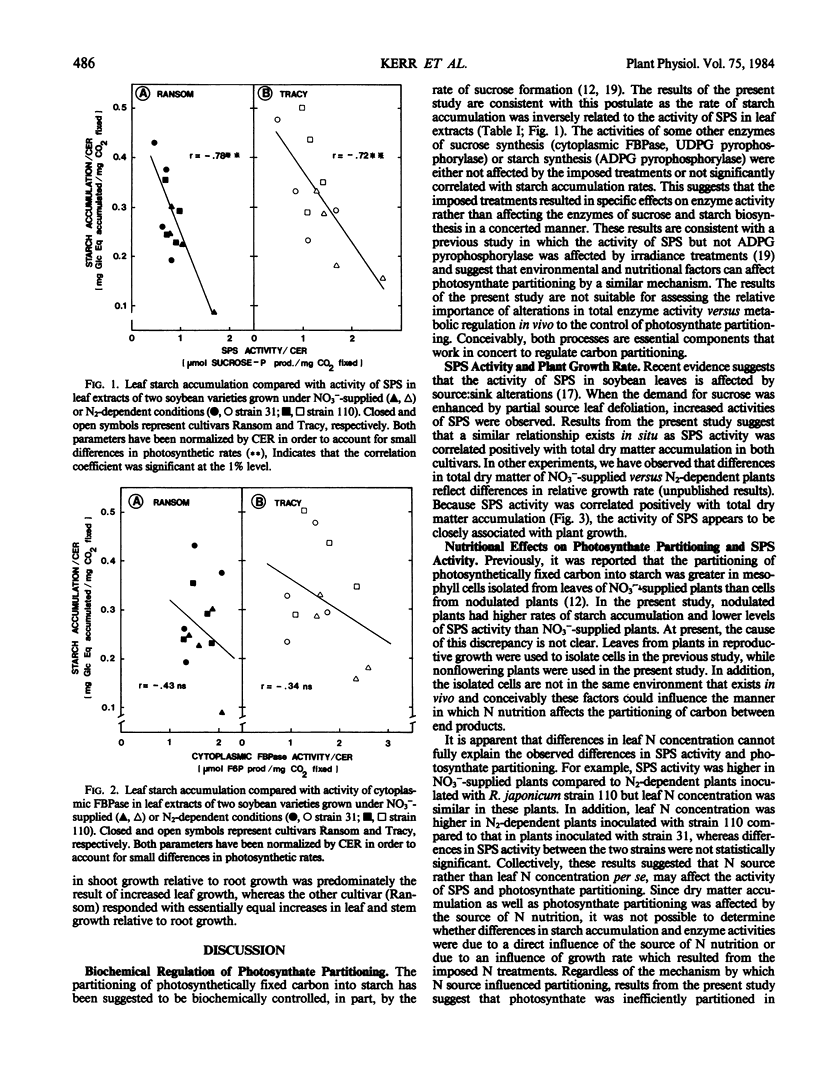Abstract
Soybeans (Glycine max L. Merr. cv Tracy and Ransom) were grown under N2-dependent or NO3−-supplied conditions, and the partitioning of photosynthate and dry matter was characterized. Although no treatment effects on photosynthetic rates were observed, NO3−-supplied plants in both cultivars had lower starch accumulation rates than N2-dependent plants. Leaf extracts of NO3−-supplied plants had higher activities of sucrose phosphate synthase (SPS) and cytoplasmic fructose-1,6-bisphosphatase (FBPase) than N2-dependent plants. The variation in starch accumulation was correlated negatively with the activity of SPS, but not the activity of FBPase, UDP-glucose pyrophosphorylase, or ADP-glucose pyrophosphorylase. These results suggested that starch accumulation is biochemically controlled, in part, by the activity of SPS. Leaf starch content at the beginning of the photoperiod was lower in NO3−-supplied plants than N2-dependent plants in both cultivars which suggested that net starch utilization as well as accumulation was affected by N source.
Total dry matter accumulation and dry matter distribution was affected by N source in both cultivars, but the cultivars differed in how dry matter was partitioned between the shoot and root as well as within the shoot. The activity of SPS was correlated positively with total dry matter accumulation which suggested that SPS activity is related to plant growth rate. The results suggested that photosynthate partitioning is an important but not an exclusive factor which determines whole plant dry matter distribution.
Full text
PDF





Selected References
These references are in PubMed. This may not be the complete list of references from this article.
- Chatterton N. J., Silvius J. E. Photosynthate Partitioning into Starch in Soybean Leaves: I. Effects of Photoperiod versus Photosynthetic Period Duration. Plant Physiol. 1979 Nov;64(5):749–753. doi: 10.1104/pp.64.5.749. [DOI] [PMC free article] [PubMed] [Google Scholar]
- Harbron S., Foyer C., Walker D. The purification and properties of sucrose-phosphate synthetase from spinach leaves: the involvement of this enzyme and fructose bisphosphatase in the regulation of sucrose biosynthesis. Arch Biochem Biophys. 1981 Nov;212(1):237–246. doi: 10.1016/0003-9861(81)90363-5. [DOI] [PubMed] [Google Scholar]
- Huber S. C., Israel D. W. Biochemical Basis for Partitioning of Photosynthetically Fixed Carbon between Starch and Sucrose in Soybean (Glycine max Merr.) Leaves. Plant Physiol. 1982 Mar;69(3):691–696. doi: 10.1104/pp.69.3.691. [DOI] [PMC free article] [PubMed] [Google Scholar]
- Huber S. C. Role of sucrose-phosphate synthase in partitioning of carbon in leaves. Plant Physiol. 1983 Apr;71(4):818–821. doi: 10.1104/pp.71.4.818. [DOI] [PMC free article] [PubMed] [Google Scholar]
- Jones M. G., Outlaw W. H., Lowry O. H. Enzymic assay of 10 to 10 moles of sucrose in plant tissues. Plant Physiol. 1977 Sep;60(3):379–383. doi: 10.1104/pp.60.3.379. [DOI] [PMC free article] [PubMed] [Google Scholar]
- McClure P. R., Israel D. W. Transport of nitrogen in the xylem of soybean plants. Plant Physiol. 1979 Sep;64(3):411–416. doi: 10.1104/pp.64.3.411. [DOI] [PMC free article] [PubMed] [Google Scholar]
- Rufty T. W., Huber S. C. Changes in Starch Formation and Activities of Sucrose Phosphate Synthase and Cytoplasmic Fructose-1,6-bisphosphatase in Response to Source-Sink Alterations. Plant Physiol. 1983 Jun;72(2):474–480. doi: 10.1104/pp.72.2.474. [DOI] [PMC free article] [PubMed] [Google Scholar]
- Zimmermann G., Kelly G. J., Latzko E. Purification and properties of spinach leaf cytoplasmic fructose-1,6-bisphosphatase. J Biol Chem. 1978 Sep 10;253(17):5952–5956. [PubMed] [Google Scholar]


